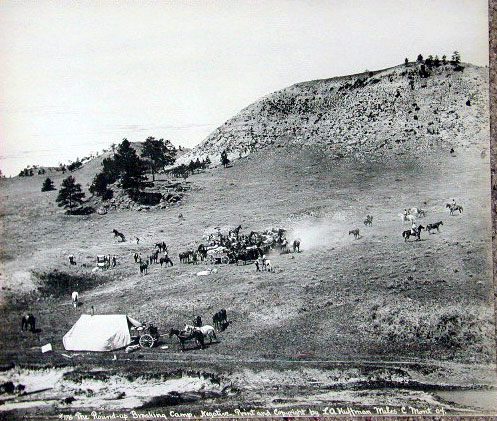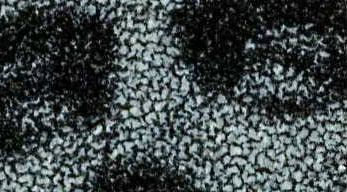|

Roundup Breaking Camp-1905-1920

Reticulated
pattern of a collotype
|
Collotype: There
is a great deal of confusion regarding the Huffman collotypes.
By far the most common question we hear is - "What is
a collotype?" Following
is our typical response:
A collotype is a print which, under magnification, has a reticulated
or grainy pattern. The image in mid tone appears to be a
mosaic of irregularly shaped cells where the inking is not continuous.
They are of high quality and "look
like photographs". They were produced mechanically and, for large editions,
were less expensive and time consuming than photographs. By comparison, a photograph
is a continuous tone image with no evidence of a grainy pattern. Photographs
are made one at a time after exposure to light through a negative, and, after
about 1900, were developed in a darkroom.
American Heritage Dictionary:
Collotype - 1. A printing process utilizing a glass
plate with a
gelatine surface carrying the image to be
reproduced. Also
called "photogelatin
process" 2. A print made by this process.
According to the "Encyclopedia of Photography", first published in
1911, collotypes first came into use in the 1860's. It states, "although
the process is still largely worked, its commercial success has been much retarded
of late years by the progress of halftone, photogravure, and other etching methods."
We're not sure where Huffman had his collotypes made; probably Chicago or New
York, possibly Minneapolis, as he did business with photographic firms in each
of those cities. We also don't know how many were made. Although
none are common, some are much more scarce than others. It's possible that
part of the scarcity could be due to lower production figures for some images.
It is not uncommon to see a collotype offered for sale in the marketplace as
an original photograph. This can have financial consequences as, all things equal,
a photo should have much greater value than a collotype.
L. A. Huffman produced collotypes of more than 40 of his images during
the period 1905 - 20. Most of them are relatively scarce and are often
confused with original photographs. Because of the vintage process and
their high quality, collotypes have become collectible on their own merit.
|

